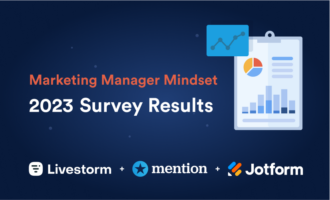The purpose of marketing and the strategies you use to achieve your goals tend to remain similar throughout your startup’s development. But marketing tactics should change throughout the company’s life cycle, from seed to launch to expansion and maturity.
Here’s another way to look at the strategic marketing process as you develop and manage your company.
Seed stage: Research and product market fit
When your small business is in its early days, it’s still just an idea. Developing your product and determining your target market is paramount.
Marketing tactics can help you determine if it’s worth taking your idea or value proposition to the next stage of development. You’ll need to learn more about your target audience, including what they need and who they are, as well as what motivates them to buy.
It’s important for early-stage startup founders to study the competition and learn how to differentiate themselves in solving customer problems. Investigate trends to see how they may influence your startup’s success.
The startup marketing strategy should also define your strengths and opportunities as well as weaknesses and threats. Finally, you’ll need to consider political, economic, social, technological, legal, and environmental factors that might impact your startup’s development.
During the seed stage, focus your marketing efforts on research, competitive analysis, customer personas, and your brand definition. It’s useful at this point to conduct some user testing for feedback, then make relevant tweaks before launch or any social media campaigns.
Launch stage: Awareness
As you prepare to launch your startup, focus on developing relationships with your target audience, providing valuable information, and connecting with them based on a shared set of values. Your aim is to build trust and credibility with early adopters while creating awareness about how your startup provides the best solution for the audience’s problem.
The launch stage of marketing should focus on messaging, product or service marketing campaigns, brand awareness, and audience engagement. Marketing efforts can also frame how and where you reach out to potential customers. This includes online marketing channels like SEO or email marketing, along with offline channels.
Growth and survival stage: Differentiation
The growth and survival stage of your business should focus on expanding to a broader audience and implementing deeper differentiation strategies. After all, other brands might be coming to market with a similar product or service — maybe even at a lower price. Competition may now be a bigger factor as you continue pursuing new customers and nurturing existing customers for repeat business.
At this stage, return to the drawing board by conducting research, getting feedback from customers through surveys, and studying the competition’s approach, albeit at a deeper level. Your marketing efforts can then exploit the differentiation strategies you’ve developed to set yourself apart in the market.
Expansion and segmentation stage: Personalization
With the amount of growth that your business has experienced, your revenue has most likely increased. Resolve to invest more into expanding your marketing activities.
That could mean entering new channels and markets, further segmenting your email list, or focusing on personalization strategies for specific customers. Consider podcasts, webinars, content marketing, pay-per-click advertising, targeting influencers, and other more specialized small business marketing strategies.
Your marketing efforts will become more about relationships and the experience you want to create for your customers and prospects. You now have extensive data that can be mined using marketing analytics tools. Those data-driven insights can help you further personalize how and when you approach existing customers. The goal is to acquire more customers and improve satisfaction following interactions with your brand.
Maturity stage: Strategic partnerships and acquisition marketing
During the maturity stage of your business, you’re on top of your industry, offering a product or service that’s widely used. Depending on your exit strategy or plans, your marketing plan will need to address other issues, including looking at strategic partnerships and acquisition marketing.
As a result, your marketing will enter what you might call the “Now what?” stage. While you want to maintain your market share, you also have other decisions to make for the company.
You could explore potential strategic relationships to grow through access to another brand’s customer base. Alternatively, your marketing may position the company as an attractive acquisition candidate for another brand with complementary products or services.
An ongoing process
As your company evolves, marketing must adapt to address new challenges and take advantage of available opportunities. Some marketing tactics work in one stage but not in others, while a few tactics can be implemented at any stage.
From both an operational and a marketing perspective, you’ll see a repetitive process at each stage as you build your business. There will be research, assessment, reflection, revision, and action. Although it may differ in details, that process becomes the framework you use to move your business forward.
Since more than one marketing formula exists, startups must stay nimble and open to change. While marketing must be based on analytical data, it still needs to be experimental, creative, and emotionally evocative. Keeping this in mind helps you leverage a best-practices approach to developing the awareness, credibility, and relationships your business needs to sustain itself throughout all stages of its life cycle.






























Send Comment: